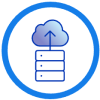What is Data Governance?
Today’s enterprise organizations collect, store, and process vast amounts of business information for business intelligence (BI). This data holds immense value, but it also presents challenges that require a concerted approach. Enterprise companies need a toolset and rules to ensure that business data is handled correctly and safeguarded.

Data governance is the system of processes, roles, policies, standards, and metrics that ensure the effective and efficient use of information to enable an organisation to achieve its goals. It ensures that data is accurate, consistent, secure, and compliant with relevant regulations.
This level of toolset makes sure that a company’s business data is used ethically, responsibly, and in a way that benefits the business organization and its stakeholders.
This article will delve into the specifics of enterprise cloud data governance, its importance, benefits, components, implementation, use cases, and more.
Why is Data Governance Important?
A data governance program isn't just a best practice; it's a necessity for modern business organizations. In the digital age, where data is a critical asset at every level, proper governance is essential for a variety of reasons:
Ensuring Data Quality
Cloud data governance establishes processes and controls to guarantee data's accuracy, consistency, and reliability throughout its lifecycle. This includes data entry, storage, transformation, and analysis. Accurate data leads to informed decision-making, efficient operations, and, ultimately, a competitive advantage.
Organisations risk making decisions based on incorrect or outdated information without an enterprise data governance program. This can result in missed opportunities, costly mistakes, and even reputational damage. By implementing data governance, organizations can ensure they're working with the highest quality data possible.
Enhancing Data Security
Data breaches and enterprise cyberattacks against business users and management are a constant threat, and the consequences can be devastating. Cloud data governance plays a pivotal role in protecting sensitive information for users by establishing security measures, policies, and protocols. This includes access controls, encryption, and monitoring to prevent unauthorized access, data leaks, and misuse.
A robust business data management framework helps business organizations identify vulnerabilities, implement safeguards, and respond effectively to security incidents. This is crucial for maintaining customer trust, complying with regulations, and safeguarding intellectual property.
Regulatory Compliance
The regulatory policy landscape surrounding data is complex, with implications for every level of users. Data governance ensures organisations understand and adhere to these regulations, whether GDPR, HIPAA, CCPA, or other industry-specific requirements.
Compliance is not just about avoiding fines and penalties; it's about demonstrating a commitment to ethical data practices and protecting the privacy of individuals.
A data governance program provides a framework for documenting data processing activities, conducting privacy impact assessments, and fulfilling data subject requests. This helps companies meet their regulatory obligations and maintain a positive public image.
What are the benefits of data governance?
High-quality enterprise data is the bedrock of sound decision-making. Data governance policy ensures that the information companies use for their strategic choices is accurate, reliable, and up-to-date.
A program helps to eliminate inconsistencies and errors, which means that data governance empowers leaders to make informed decisions with confidence – because they know the data is reliable. It leads to better outcomes and a competitive advantage.
Enhanced Data Security
We see a constant escalation in the level of cloud cyber threats, which means that program data security is now a paramount need. Data governance supports a holistic approach to safeguarding sensitive information.
Robust enterprise security measures, access controls, and monitoring systems for your data warehouse ensure that organizations can mitigate the risk of data breaches, unauthorized access, and misuse. This not only protects valuable assets but also preserves customer trust and brand reputation.
Regulatory Compliance
The regulatory needs and mandates are constantly changing, and it’s not easy to keep up. A data governance program supports companies in learning a more structured approach to compliance. This means that companies need to make sure that their data handling practices align with a high level of legal requirements and industry standards.
By proactively addressing compliance, business organizations can avoid costly fines, legal battles, and reputational damage.
Increased Operational Efficiency
Data governance streamlines data processes, reduces redundancies, and optimises resource allocation. Governance involves establishing clear workflows and responsibilities so that organisations can improve efficiency and productivity.
It translates to faster access to enterprise information, smoother collaboration across departments, and a more agile and responsive organisation.
Cost Reduction
Efficient data management has another big benefit: working with data in a streamlined way can support significant cost savings. Data governance identifies and eliminates duplicate data, reduces storage costs, and optimizes data infrastructure.
What’s more, minimizing the risk of cloud data-related errors and rework support organisations to save time and resources, ultimately improving their bottom line.
Enhanced Customer Experience
Data governance ensures that customer data is accurate, complete, and up to date. This allows organizations to personalize customer interactions, offer targeted products and services, and deliver a seamless customer experience. By prioritising data quality, organisations can build stronger customer relationships and drive the need for loyalty.
Data-Driven Innovation
Data governance lays the foundation for enterprises to learn data modelling innovation. By making data policy accessible and understandable to the right people, organizations can unlock valuable insights and foster a culture of innovation. This need can lead to developing new products, business services, and business models that drive growth and differentiate the organisation in the market.
Core Components of Data Governance
Effective data governance relies on a few key components working together seamlessly. These components provide the structure, rules, and processes needed to manage data effectively:
- Data stewardship: At the heart of a data governance program, individuals or teams are responsible for learning to oversee specific data assets or domains. Data stewards ensure data quality, accuracy, and compliance with policies and standards.
- Data policies and cloud standards: Data policies and standards are the rules of the road for team data governance. They define how data should be collected, stored, accessed, used, and shared. These policies and standards ensure consistency and prevent data misuse.
- Data management processes: Data management processes are the workflows and procedures needed to govern how data is handled throughout its lifecycle. This includes data creation, collection, storage, processing, analysis, and disposal.
- Data lifecycle and workflow: Understanding the data lifecycle is crucial for effective data management. The lifecycle includes all the stages that data goes through, from its creation to its disposal. Each stage presents different challenges and opportunities for data governance.
A well-defined data workflow also outlines the steps involved in each lifecycle stage. This helps ensure that data is handled consistently and efficiently and meets the required quality standards. It also helps identify potential bottlenecks or areas for improvement.
How to Implement Data Governance
Implementing data governance is a journey, not a destination. It requires a well-thought-out plan and a commitment to support continuous improvement. Here's a roadmap to guide you through the implementation process:
Developing a Data Governance Framework
A data governance framework is the foundation of your data governance program. It outlines the goals, principles, roles, and responsibilities that guide your data management practices. The framework should be aligned with your business organization's overall strategy and objectives.
Tools and Technologies
The best tools and technologies can streamline team data governance and make it more effective. A wide variety of the best tools are available, ranging from a data catalog and data lineage tools to identity and access management (IAM) and metadata management tools.
Consider your organisation's specific needs and budget when selecting tools and technologies. It's also important to choose tools that are easy to use and integrate with your existing systems.
Measuring Success
Data governance is an example of an ongoing process, not a one-time project. It's important to regularly measure your team's data governance program's success to ensure that it's meeting its objectives. For example, this can be done through various metrics, such as data quality, compliance, and user satisfaction surveys.
Remember, implementing data computing governance is a journey. It takes time, effort, and commitment. But the benefits are well worth it. With a well-implemented data governance program, you can ensure that your data is accurate, secure, and compliant. This will enable your organization to make better decisions, improve operational efficiency, and gain a competitive advantage.
How Do I Start with Data Governance?
Embarking on a data analytics journey may seem daunting, but it doesn't have to be. Here's a simplified approach to get you started on data architecture that facilitates good governance:
- Define your objectives: Begin by clearly articulating what you want to achieve with data governance analytics. Are you aiming to improve data storage quality, enhance security, ensure compliance, or all of the above? Defining your objectives will help you tailor your data governance program to your specific needs.
- Identify key stakeholders: Cloud data governance is an example of something that requires a collaborative effort. Identify the individuals and teams with a stake in data and involve them from the outset. This includes data owners, data stewards, IT professionals, business leaders, and legal and compliance experts.
- Assess your current state: Conduct a comprehensive analytics assessment of your existing data management practices. This will help you identify gaps, risks, and areas for improvement. Consider factors such as data quality, data security, compliance, and data literacy within your organisation.
- Develop a data governance roadmap: Create a roadmap for implementing the best data governance analytics based on your objectives and assessment. This should outline the steps you'll take, the resources you'll need, and the timeline for implementation. Prioritize your actions based on the most critical areas for improvement.
- Start small, scale up: Don't try to tackle everything at once. Begin with a pilot project focused on a specific data domain or use case. This will allow you to test your approach, gather feedback, and refine your processes before scaling up to the entire organization.
Data governance analytics is not just about technology and processes; it's about people, too. Communication is the key to data governance, and training should be provided to ensure that everyone understands their roles and responsibilities.
Use Cases of Data Governance
Data governance isn't a one-size-fits-all solution; it's adaptable to the unique needs and challenges of various industries.
Financial institutions handle vast amounts of sensitive data, making them prime targets for cyberattacks and fraud. Data governance helps mitigate these risks by ensuring the accuracy, integrity, and security of financial data. It also enables compliance with stringent regulations like Basel III, GDPR, and Anti-Money Laundering (AML) laws e.g. PCI DSS.
There’s also the healthcare sector. Protecting patient health information (PHI) is not only a legal requirement but also an ethical imperative – through HIPAA in part.
Data governance in healthcare establishes strict protocols for data access, storage, and analytics, safeguarding patient privacy and confidentiality. It also ensures the accuracy of medical records, enabling informed decision-making and better patient outcomes.
Finally, governments hold a wealth of citizens, infrastructure, and public services data. Data governance such as CCPA supports transparency, accountability, and responsible use of this data. It also supports analytics compliance with public records laws and open data initiatives, fostering trust between government agencies and the public.
OVHcloud and Data Governance
OVHcloud's managed database services offer the best advantages for businesses seeking to maintain data protection control over their data assets while accelerating their cloud initiatives.

By taking on the responsibility of database infrastructure and administration, including setup, backup, scalability, and security, putting information on OVHcloud dedicated servers frees up valuable time and resources for businesses to focus on developing and deploying applications.

